
Square planar and Octahedral species
 المؤلف:
CATHERINE E. HOUSECROFT AND ALAN G. SHARPE
المؤلف:
CATHERINE E. HOUSECROFT AND ALAN G. SHARPE
 المصدر:
INORGANIC CHEMISTRY
المصدر:
INORGANIC CHEMISTRY
 الجزء والصفحة:
p48
الجزء والصفحة:
p48
 7-7-2016
7-7-2016
 5176
5176
Square planar species
In a square planar species such as [ICl4] - or [PtCl4]2- (1.22), the four Cl atoms are equivalent. Similarly, in [PtCl3(PMe3)] - (1.23), there is only one possible arrangement of the groups around the square planar Pt(II) centre.

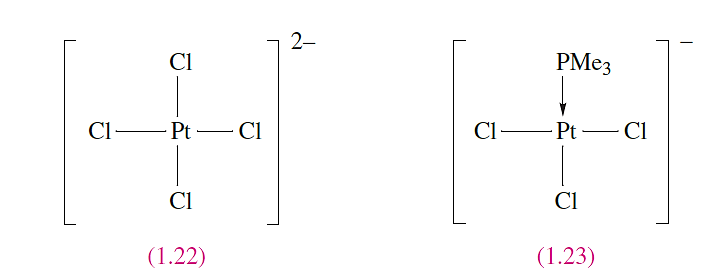
The introduction of two PMe3 groups to give [PtCl2(PMe3)2] leads to the possibility of two geometrical isomers, i.e. two possible spatial arrangements of the groups around the square planar Pt(II) centre. These are shown in structures 1.24 and 1.25 and the names cis and trans refer to the positioning of the Cl (or PMe3) groups, adjacent to or opposite one another.


Square planar species of the general form EX2Y2 or EX2YZ may possess cis- and trans-isomers.
Octahedral species
There are two types of geometrical isomerism associated with octahedral species. In EX2Y4, the X groups may be mutually cis or trans as shown for [SnF4Me2]2- (1.26 and 1.27). In the solid state structure of [NH4]2[SnF4Me2], the anion is present as the trans-isomer.

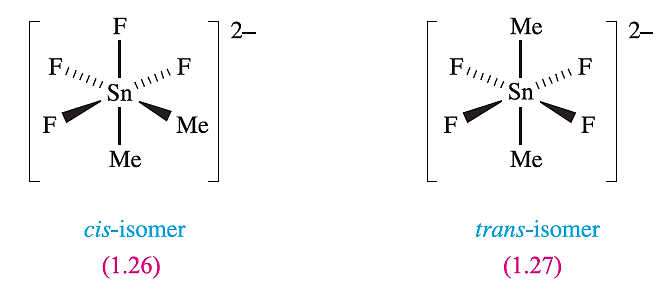
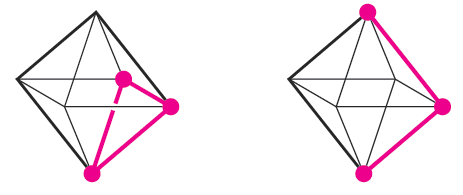
Fig. 1.1 The origin of the names fac- and mer-isomers. For clarity, the central atom is not shown
If an octahedral species has the general formula EX3Y3, then the X groups (and also the Y groups) may be arranged so as to define one face of the octahedron or may lie in a plane that also contains the central atom E (Figure 1.1). These geometrical isomers are labelled fac (facial) and mer (meridional) respectively. In [PCl4][PCl3F3], the [PCl3F3]- anion exists as both mer- and fac-isomers (1.28 and 1.29).
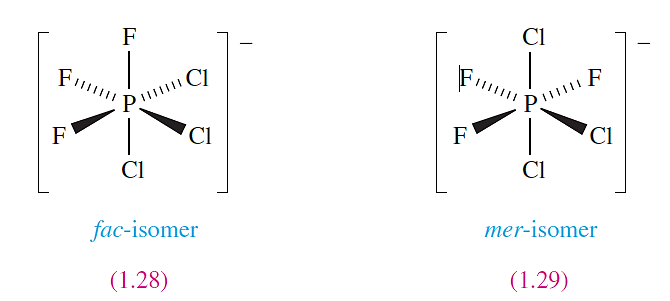

An octahedral species containing two identical groups (e.g. of type EX2Y4) may possess cis- and trans arrangements of these groups. An octahedral species containing three identical groups (e.g. of type EX3Y3) may possess fac- and mer-isomers. Trigonal bipyramidal species In trigonal bipyramidal EX5, there are two types of X atom: axial and equatorial. This leads to the possibility of geometrical isomerism when more than one type of substituent is attached to the central atom. Iron pentacarbonyl, Fe(CO)5, is trigonal bipyramidal and when one CO is exchanged for PPh3, two geometrical isomers are possible depending on whether the PPh3 ligand is axially (1.30) or equatorially (1.31) sited.

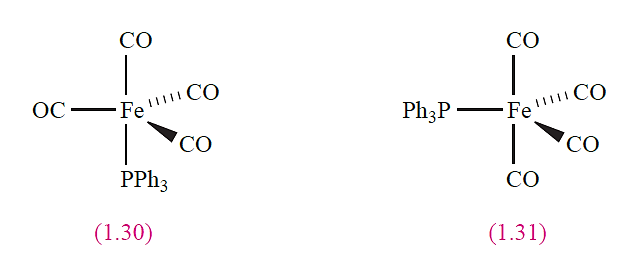
For trigonal bipyramidal EX2Y3, three geometrical isomers (1.32 to 1.34) are possible depending on the relative positions of the X atoms. Steric factors may dictate which isomer is preferred for a given species; e.g. in the static structure of PCl3F2, the F atoms occupy the two axial sites, and the larger Cl atoms reside in the equatorial plane.


In a trigonal bipyramidal species, geometrical isomerism arises because of the presence of axial and equatorial sites.
 الاكثر قراءة في مواضيع عامة في الكيمياء اللاعضوية
الاكثر قراءة في مواضيع عامة في الكيمياء اللاعضوية
 اخر الاخبار
اخر الاخبار
اخبار العتبة العباسية المقدسة


